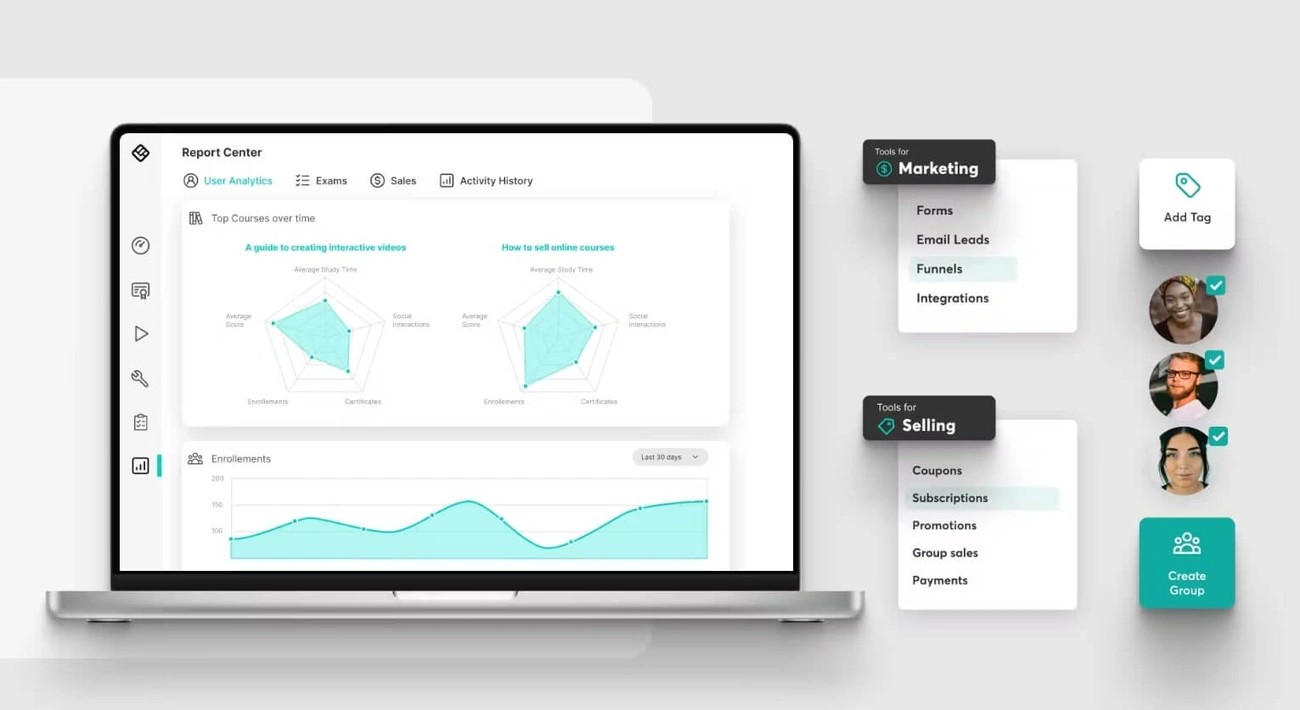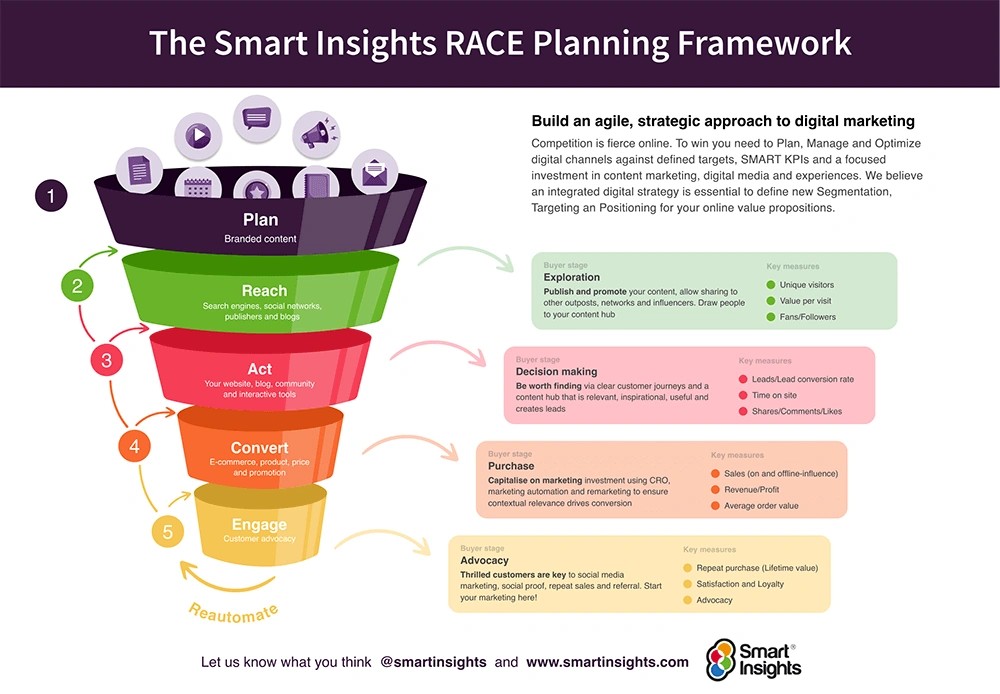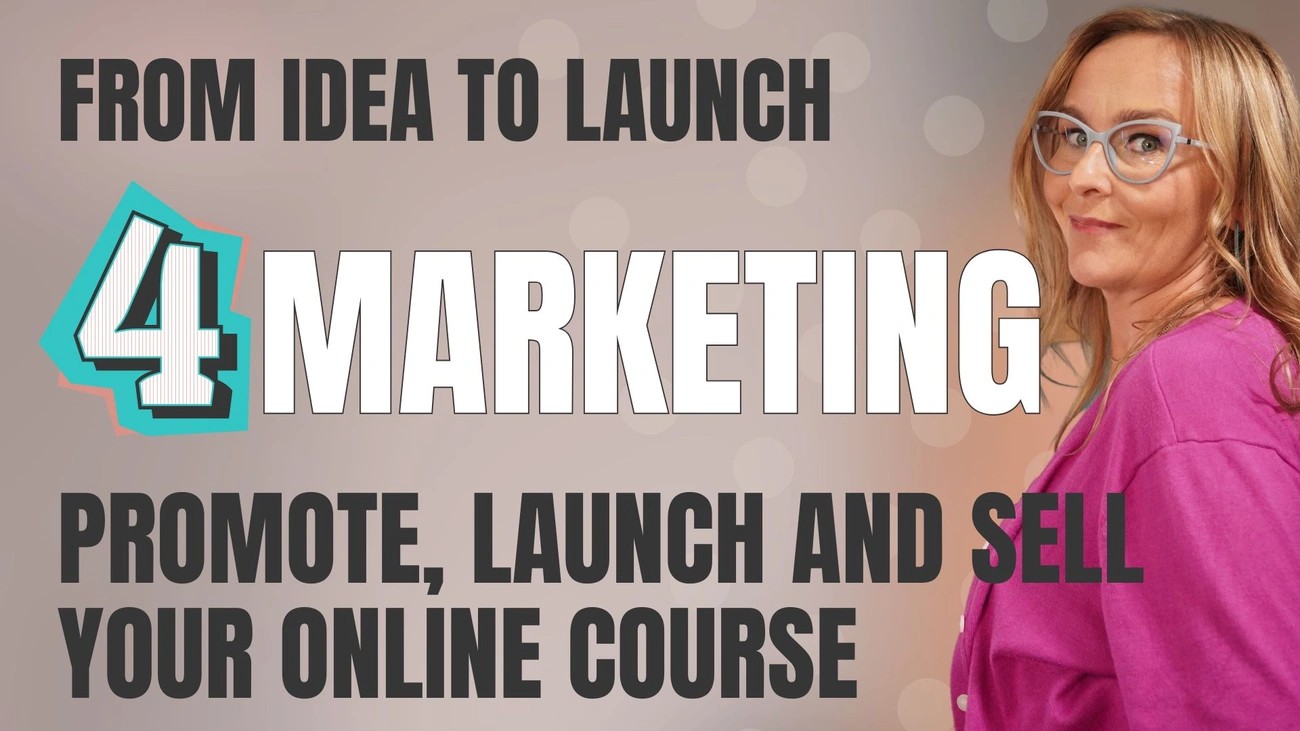Does analysis paralysis have you stuck on your online course launch? You might miss significant elements that could determine your course launch success with so many moving parts involved .
The wrong sequence leads many course creators to create poorly structured courses. This results in lower enrollment rates and missed revenue opportunities . Your online course launch strategy’s success depends on setting up the right pieces of your marketing funnel and sales approach beforehand . A well-organized approach during planning and launch phases will help your online course discover its full potential .
The success of your first course opens doors to build an online academy, membership site, or client training library . A detailed course launch checklist helps you break down overwhelming complexity into simple steps you can follow.
This piece walks you through a proven online course launch checklist that delivers results. The checklist covers everything from building your foundation to executing your launch and analyzing results. These steps will help you avoid common pitfalls and maximize your success, whether you’re new to course creation or planning your next launch.
Start with a Solid Foundation
Your trip to a successful online course starts before your first student signs up. A rock-solid foundation will give your course the power to succeed. Research shows because no market exists for their product 42% of entrepreneurs fail[1]. Let’s build your course’s foundation step by step to avoid this mistake.
Pick your course topic and name
The right course topic is your first significant decision. Focus on finding a niche where you can add real value instead of tackling a broad subject. Technology, business, arts, health, and personal development rank among the most profitable online course subjects [1].
These four essential elements matter when picking your topic:
- Passion: Pick something you’ll enjoy thinking about for months or years
- Skills: Make sure you have specific expertise to teach well
- Experience: Use your unique professional or personal background
- Target audience: Know who will gain from your knowledge [2]
After settling on your topic, you need a perfect name. Note that —your course title must show value right away people stay on a web page for only 10-20 seconds[3]. Choose clarity over creativity. Show the outcome students will achieve, and keep your title under 65 characters so it shows up fully in search results.
Take this example: “Enjoy Any Wine with Any Food” works better than “Wine Pairing 101″—it shows the benefit students will get right away [3].
Define your transformation promise
Most course creators start with content instead of transformation. This leads to information overload or poor content organization [4].
Ask yourself: “Where are my students now, and where should they be after finishing my course?” This helps you filter your knowledge and create a path to meaningful results [4].
Your transformation promise needs these three key elements:
- What students will be able to DO after the course
- What students will KNOW by the end
- How students will FEEL upon completion [2]
Complete this statement: “By the end of this course, you will be able to…” [5]. This framework sells more than just information—it offers a clear path to change.
Rupa Pro can help if you struggle with your transformation promise. It turns your existing content into a complete course outline automatically, giving you solid ground to build on.
Set your launch date and goals
Your course might stay “almost ready” forever without a firm timeline. Pick a launch date 3-4 weeks ahead to give yourself enough prep time [6]. This creates good pressure while leaving room to build your launch strategy.
The SMART method works best for launch goals—make them specific, measurable, attainable, realistic, and timely [7]. Define exact enrollment numbers and deadlines instead of vague goals like “get many students.”
Research proves that writing down goals works. One study showed 76% of people reached their goals when they wrote them down, shared action plans, and updated friends weekly. Only 43% succeeded with unwritten goals [7].
Set these key milestones:
- Course completion date
- Pre-launch marketing activities
- Number of beta testers to recruit
- Target enrollment for launch week
- Revenue goals for the first month
A strong foundation—tested topic, clear transformation promise, and specific launch goals—sets your online course up for success from day one.
Build Your Course and Platform

Image Source: LearnWorlds
Your course foundation looks solid. Let’s bring your digital masterpiece to life. Your transformation promise sets the stage. Now you need thoughtful design and the right platform choice.
Create your course outline and content
A detailed course outline drives your online course success. A well-laid-out outline splits content into bite-sized pieces. This creates a flow that helps students direct through your material without effort [8]. Your outline serves dual purposes – it helps you plan and shows learners what to expect.
Break down broad learning goals into specific, measurable objectives for each module. Ask yourself: “What will learners be able to do after completing this section that they couldn’t do before?” [9]. This makes sure every piece of content helps deliver your promised transformation.
Your course modules should:
- Stay short and focused with gradual difficulty increases
- Follow a topical outline that groups subtopics under main topics
- Mix in interactive elements to boost student involvement
- Include regular assessments to track progress [9]
Storyboards help visualize content connections, especially with multimedia elements [8]. Both you and your students will see how knowledge links together throughout your course.
Time estimates for each section make a big difference. This small detail can boost completion rates. Students plan their learning trip better and feel less overwhelmed [10].
Choose a platform to host your course
The right platform choice shapes everything – from content creation to student experience and growth potential. Course platforms give you tools and resilient infrastructure to build engaging learning experiences. They handle technical details while you create valuable content [11].
Look for these vital features when picking a platform:
- User-friendly course builder: Find platforms with drag-and-drop features that work with videos, audio, text, and interactive content [11]
- Customization options: Make sure you can line up the design with your brand [11]
- Payment processing: Check if the platform works with trusted payment systems and flexible pricing [11]
- Student engagement tools: Look for discussion forums, quizzes, and assessment features [11]
with quick setup and ease of use Teachable stands out[12]. Kajabi offers business-building features [13]. Thinkific gives beginners a strong free tier [13]. Tools like Rupa Pro can speed things up by turning existing content into course outlines quickly.
Set up course settings and student experience
Student experience drives completion rates and launch success. Start with a solid onboarding process. Add a welcome lesson that shows course structure and points to key resources [3].
Build clear navigation paths with consistent elements. Templates balance teaching style with student needs. This supports availability and consistency on every platform [14]. Add multimedia resources and assessments that match learning goals for an engaging environment [14].
Boost student experience with:
- Individual-specific learning paths using drip-feed or lesson locks [3]
- Design elements that stay consistent throughout [3]
- Designs that work smoothly on mobile devices [14]
- Full orientation programs that explain technology and set expectations [14]
Accessibility isn’t optional – it’s vital. Make digital materials and platforms work for students with disabilities. This creates fair and inclusive online education [14].
A detailed course outline, the right platform, and great student experience set you up for success. Your course launch will deliver the transformation you promised.
Craft Your Course Launch Strategy

Image Source: Smart Insights
Your course launch strategy bridges the gap between creation and successful enrollment. Even great content needs smart marketing to turn interested prospects into paying students.
Design your sales funnel and lead magnet
A well-laid-out sales funnel guides potential students toward enrollment. The funnel has : top (awareness), middle (consideration), and bottom (decision) three stages[15]. Each stage needs different content to move prospects closer to buying.
Start by getting attention through valuable content like blog posts, videos, or social media posts [16]. The real magic happens when you turn casual viewers into leads with a great lead magnet—a free resource they get in exchange for their email.
Your lead magnets should be:
- Specific: Give one clear solution or quick win
- Relevant: Connect directly to your course topic
- Trust-building: Show your expertise and teaching style [4]
Popular formats are mini-courses, checklists, templates, short guides, or assessments [4]. To cite an instance, if you teach digital marketing, a “30-Day Social Media Content Calendar Template” gives quick value and naturally flows into a complete course on social strategy.
Lead magnets do more than collect emails—they start your value ladder by giving real help to prospects [17].
Plan your email and social media campaigns
Email marketing works amazingly well for course launches—it’s at getting new customers than social media 40 times better[18]. Make your launch work with three key email sequences:
- Pre-launch sequence: Build excitement 2-4 weeks before launch with helpful content and success stories
- Launch sequence: Get sign-ups during cart-open week with 3-4 timed emails
- Post-launch sequence: Welcome students and get their feedback [19]
Mix promotional and helpful content—try one sales email for every three informative ones [18]. Add social proof through testimonials and create urgency with limited-time offers to boost sign-ups.
Your social media strategy should work with your email campaign. Share useful content about your course topic, build interest with “behind-the-scenes” looks, and stay active during launch week [20].
Create a webinar or live event strategy
Webinars help course creators combine teaching and selling effectively. Live webinars create urgency and connection—students experience your teaching style firsthand [21].
Your webinar strategy should:
- Pick one specific problem your course solves
- Give real value before selling
- Add interactive elements like polls, Q&A, or chat
- Give special bonuses to live attendees
- Send recordings to those who missed it [21]
Not sure about making a full course? Test your content with a paid webinar first. This “webinar-first” approach lets you check interest with less risk while making money to fund your complete course [22].
These three elements—a solid sales funnel with great lead magnets, smart email and social campaigns, and engaging live events—create multiple ways to guide students toward enrollment. Rupa Pro makes this easier by turning your content into course outlines and handling marketing tasks automatically. You can focus on teaching instead of dealing with complex tech systems.
Prepare Your Launch Content
Content creation is a vital link between your launch strategy and actual sales. Your plan is set, and now you need specific materials that will turn prospects into paying students.
Write nurture and promo emails
Email sequences drive most of your course sales. You need both nurture and promotional emails to build relationships before asking for the purchase. Nurture emails help you build trust with subscribers through valuable content that showcases your expertise without being too salesy. These emails help warm up your audience before your course launch.
Your email campaign needs three distinct sequences:
- Pre-launch sequence: 5-6 nurturing emails before launch to build awareness and understanding
- Launch sequence: Conversion-focused emails during cart-open period
- Post-launch sequence: Welcome messages and feedback collection after purchase
Nurture emails should provide educational content that establishes your authority and shares personal stories your subscribers can relate to. Your promotional emails need testimonials and time-limited offers to create urgency. Note that it takes an average of , which makes a complete email sequence vital 8 touchpoints to make a sale[7].
Design Instagram and blog content
Your message becomes stronger when you create consistent content on multiple platforms. Instagram posts see a 0.98% median engagement rate, which is lower than email conversion rates. However, strategic social content still adds valuable visibility [7].
Instagram works well with these course-specific content ideas:
- Behind-the-scenes glimpses of course creation
- Student success stories and testimonials
- Quick tips related to your course topic
- Countdown posts building excitement
Your blog acts as a content hub where you can add calls-to-action and content upgrades to each post. This strategy makes growing your email list much easier [6]. The blog becomes the foundation to repurpose content across different platforms and reach various audiences [23].
Starting content creation early—even before your course is ready—helps you build an audience. This timing allows content to gain traction in search engines and gives you practice finding your voice [23].
Record and schedule your webinar
Webinars are powerful conversion tools during your launch. Start preparations at least a month ahead, with increased promotion in the final week when most people register [24].
Your webinar needs:
- Custom email invitations and reminders
- Branded images and your logo
- Recording for future use as a lead magnet
- Follow-up with attendees within 24 hours
The key is to deliver genuine value before moving to your sales pitch. Polls and Q&A sessions help boost engagement. Prospects are if they receive marketing materials within an hour of your webinar 60x more likely to convert[25].
Rupa Pro makes this content creation process simpler by turning your existing material into course outlines and handling marketing automation. This lets you focus on delivering value instead of dealing with technical systems.
Execute Your Launch Week Plan

Image Source: Gerta.eu
The big moment is here—it’s launch week! Your preparation will conclude in these vital days where precise execution determines whether your launch soars or sinks. Let’s take a closer look at the actions that boost enrollments during this critical period.
Send launch emails and go live
Your cart opening makes email your strongest conversion tool. Unlike occasional social posts, your launch emails need a strategic sequence:
Note that announcement emails should grab attention right away by showcasing your course’s value and building excitement. You should send reminder emails that highlight limited-time deals to create urgency [26]. Be ready to answer all questions from potential students quickly—your response time affects conversion rates directly.
Your email campaign should include these specific touchpoints:
- An official announcement when registration opens
- Special offer emails with time-sensitive incentives
- “Last chance” reminders as cart closing approaches [26]
Host your webinar and offer bonuses
Webinars are conversion powerhouses during launch week. Your presentation should deliver real value before smoothly transitioning to your course offer. You can add interactive elements like Q&A sessions, polls, and live chat to increase participation and build personal connections with potential students [21].
The right moment arrives to introduce bonuses that overcome purchase hesitation. build urgency—you can offer them just to webinar attendees or during the first 24-48 hours after your presentation Limited-time bonuses[1]. These could include templates, resource libraries, or extra coaching sessions that improve your main offering without artificially inflating its value [2].
Post daily on social media
Your previous posting might have been occasional, but launch week needs daily updates. You should post at least once daily to keep momentum strong and generate conversions [5]. Your content mix should keep followers interested:
- Promotional announcements about your course
- Educational snippets showcasing your expertise
- Behind-the-scenes glimpses into your launch
- Student testimonials as social proof [5]
Scheduling tools can automate your posts so you can focus on engaging with comments and questions. Watch your performance metrics throughout the week to see what connects with your audience and adjust your strategy [5].
Tools like Rupa Pro can simplify these launch week activities by automating email sequences and tracking engagement metrics. This lets you concentrate on meaningful interactions with potential students instead of dealing with technical details.
Post-Launch Follow-Up and Growth
The course is now live! In spite of that, your work doesn’t end at launch. The right follow-up can turn a one-time event into long-term growth.
Collect student feedback and reviews
You should of enrollment to ensure they can access your materials easily connect with new students within 24 hours[20]. A welcome sequence will guide them through their first steps and encourage them to participate. Your surveys should ask three key questions:
- What is their biggest challenge regarding your topic?
- Which description best represents their situation?
- What held them back from joining sooner? [9]
These answers show what works well and point out areas where your course content and delivery methods need improvement [20].
Analyze your sales and funnel data
Keep detailed tracking of metrics after launch. Watch your email open rates, click-through rates, and conversion percentages [20]. Your analysis should cover which marketing channels worked best, including Google ads, social media campaigns, and email sequences [8].
This information helps you make your future launches better and shows which strategies appealed most to your audience [20].
Plan your next course or relaunch
The analysis will help you build systems that grow with your course business. You should think over:
- Developing automated email sequences for future students
- Establishing clear metrics to measure success beyond launch day
- Building a content calendar supporting ongoing engagement [20]
Note that version 2.0 of your course should include student feedback. Think of your digital product as software that gets better with time [27].
Conclusion
Creating an online course needs careful planning at every stage. This piece outlines a proven checklist that makes the overwhelming process more manageable. Successful course creators know that good preparation works better than improvisation.
A solid course foundation shapes everything that follows. A clear transformation promise, confirmed topic, and specific launch goals boost your chances of success. Students don’t just buy courses—they buy outcomes.
The course creation phase needs equal focus on content quality and platform choice. Instead of getting caught up in endless details, deliver your transformation promise through well-laid-out modules. Rupa Pro can make this easier by turning your existing content into complete course outlines. This saves you planning time and ensures you don’t miss anything important.
Your launch strategy ended up determining if your well-crafted course reaches its target audience. Email sequences, webinars, and strategic content guide potential students toward enrollment. It also creates multiple connected touchpoints that build trust before the purchase.
Launch week brings both excitement and pressure. All the same, being organized during this vital period pays off. Quick responses to questions, engaging webinar talks, and active social media presence build momentum toward enrollment goals.
The post-launch phase offers growth opportunities rather than an endpoint. Student feedback, sales analysis, and continuous improvement pave the way for greater success with future courses.
Note that your first course launch is just the start of your creator experience. Each step builds valuable skills that make future launches easier and more profitable. Tools like Rupa Pro handle technical aspects of course creation and marketing automation. This lets you focus on what matters most—giving exceptional value to your students.
Begin with what you have now. Though perfection seems out of reach, taking action beats doing nothing. Your expertise deserves to be shared, and someone needs exactly what you can teach. Take that first step today.
Key Takeaways
Launching a successful online course requires strategic planning and systematic execution across six critical phases, from foundation-building to post-launch optimization.
• Start with transformation, not information – Define exactly what students will achieve after completing your course rather than just dumping knowledge • Build your email list before launch – Email marketing is 40x more effective than social media for acquiring customers and driving course sales • Use webinars as conversion powerhouses – Live presentations let prospects experience your teaching style while creating urgency through time-sensitive offers • Execute a structured launch week plan – Send strategic email sequences, host engaging webinars, and maintain daily social media presence for maximum enrollment impact • Analyze and optimize post-launch – Collect student feedback within 24 hours and track funnel metrics to improve future launches and build sustainable growth
The key to course launch success lies in treating it as a systematic process rather than a one-time event. Each phase builds upon the previous one, creating momentum that transforms your expertise into a profitable online business while genuinely helping students achieve their goals.
FAQs
Q1. What are the key steps to successfully launch an online course? Start by building an audience and defining your course pricing strategy. Then, develop a marketing plan, customize your online school, create a compelling sales page, announce your launch, and actively promote your course through various channels.
Q2. How should I structure my online course content? Divide your content into digestible modules or chunks. Organize these modules by topics, lessons, or time frames (e.g., daily, weekly). This consistent structure helps students navigate the course more easily and enhances their learning experience.
Q3. What’s an effective way to introduce online training? Begin with a captivating story or use a catchy headline to grab attention. Present learning objectives creatively, introduce a “what if” scenario to spark interest, or use a short introductory video to set the tone for your course.
Q4. How can I promote my online course on social media? Collaborate with influencers, build anticipation using polls, offer early-bird discounts, create trailer videos, post short content snippets, utilize Pinterest, showcase social proof, and create engaging LinkedIn carousels to maximize your course’s visibility.
Q5. What should I focus on during the post-launch phase of my online course? After launching, collect student feedback promptly, analyze sales and funnel data to understand what worked well, and use these insights to plan improvements for your next course or relaunch. Continuously engage with your students and optimize your course based on their experiences.
